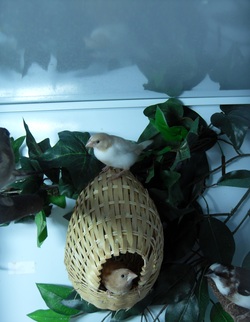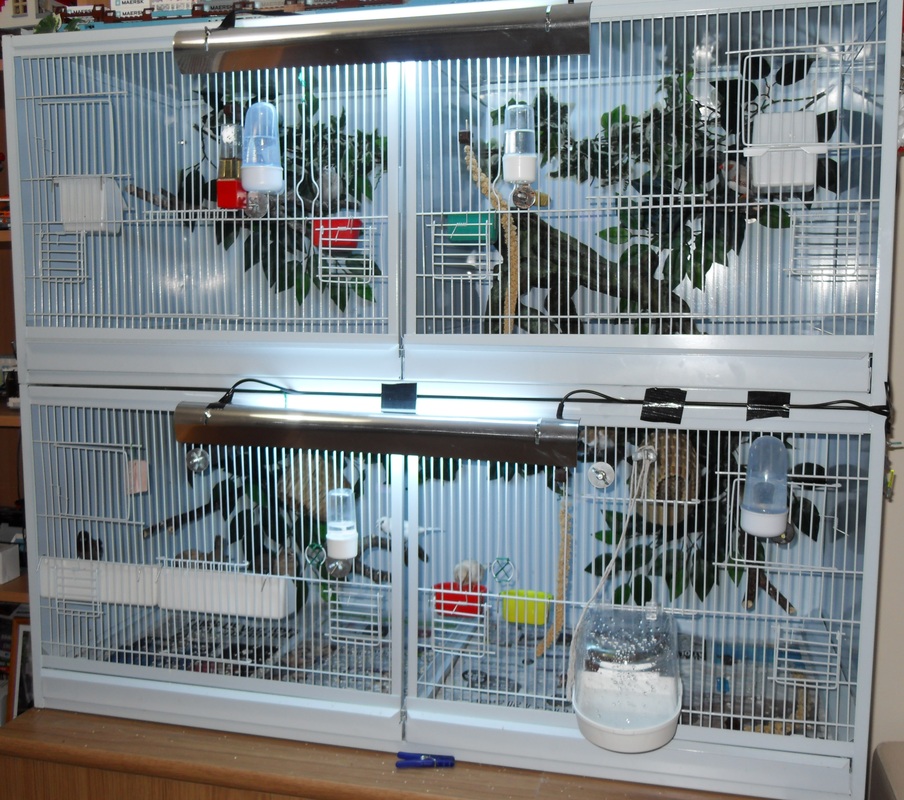At the moment the finches are living in 2 large breeding cages. These are 120cm long, 50cm deep and 50cm high. We chose these cages because they are stackable and give the finches room to fly backwards and forwards. As the cages are not bars all round, there is less worry of the finches getting their legs or nails caught, plus mess only leaves the cages in one direction.

The cages include silk leaves and vines hanging on the back. The silk leaves are more decorative, but the silk vines are good for hanging nests on, plus the Cherries and Bengalese finches enjoy sleeping on them as it gives them cover.
The cages came with plastic perches and small feeders, but we opted for seed troughs which were approximately three times longer, and wooden perches of varying widths. We also included pedi perches to help maintain short nails.
The cages came with plastic perches and small feeders, but we opted for seed troughs which were approximately three times longer, and wooden perches of varying widths. We also included pedi perches to help maintain short nails.
The bottom of each cage has two slide out trays, which are invaluable for cleaning while minimising finch stress levels.
To encourage breeding the bottom of each cage is laid with dust free hay on newspaper. The cages also have dividers, which allow you to divide each cage into equal halves.
Originally we used daylight bulbs in the bird room, but we have recently purchased a UV lighting system designed for reptiles. The lighting gives full spectrum lighting, with UVA and UVB reaching most of the cage with its 30cm effective range.
The finches get fed foreign finch seed mix daily, with millet, egg food and veggies as treats. Originally, treats were given every 2 or 3 days, but once the Bengalese finches had chicks, we have been feeding them millet, egg food and veggies daily, in addition to the seed mix. We make the egg food our selves by crushing up hard boiled eggs. Small trays are also included which contain a mix of coal and cuttlefish, which act as a more soluble form of grit.
Our finches love bathing, so we give them fresh water in an external finch bath for an hour each day.
To encourage breeding the bottom of each cage is laid with dust free hay on newspaper. The cages also have dividers, which allow you to divide each cage into equal halves.
Originally we used daylight bulbs in the bird room, but we have recently purchased a UV lighting system designed for reptiles. The lighting gives full spectrum lighting, with UVA and UVB reaching most of the cage with its 30cm effective range.
The finches get fed foreign finch seed mix daily, with millet, egg food and veggies as treats. Originally, treats were given every 2 or 3 days, but once the Bengalese finches had chicks, we have been feeding them millet, egg food and veggies daily, in addition to the seed mix. We make the egg food our selves by crushing up hard boiled eggs. Small trays are also included which contain a mix of coal and cuttlefish, which act as a more soluble form of grit.
Our finches love bathing, so we give them fresh water in an external finch bath for an hour each day.

 RSS Feed
RSS Feed